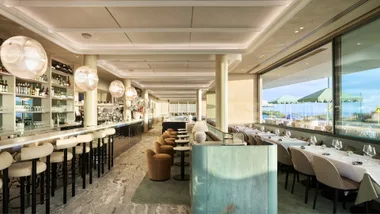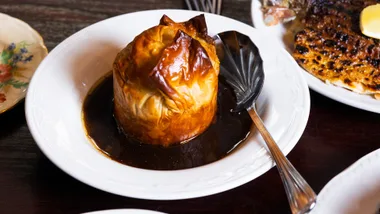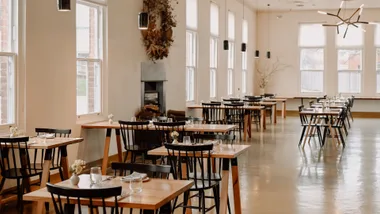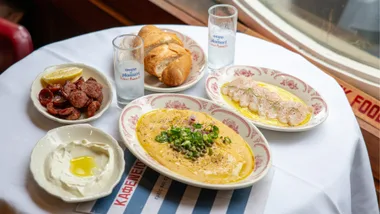San Telmo
14 Meyers Pl (between Bourke & Little Collins sts),
Melbourne, (03) 9650 5525, santelmo.com.au.
Licensed.
Cards AE D MC V EFT.
Open Mon-Wed 7am-11pm; Thu-Fri 7am-midnight; Sat noon-midnight.
Prices Entrées $6-$18; mains $22-$49; desserts $5-$14.
Vegetarian 10 starters and sides.
Noise Buzzy.
Wheelchair access Yes (enter from Windsor Pl).
Plus Authentic Argentine atmosphere deftly avoids theme park.
Minus Some may baulk at the all-Argentine wine list.
If “life is better with chimichurri” isn’t already an old Argentine saying, it should be, especially when the conversation is about the smoky goodness of a charcoal grill. And while there may be a million small variations on the sauce’s theme of parsley, garlic, vinegar, dried chilli, oil and oregano (a squeeze of lemon or lime juice here, some coriander there), and while it can range from chunky and salsa-like to smooth and oily, the truth still stands: a slather of chimichurri on beast, fish, fowl or vegetable reaps a load of rewards.
Melburnians are now road-testing the theory at San Telmo, the Argentine restaurant in Meyers Place named after Buenos Aires’s oldest barrio. Its house-made chimichurri is an authentic beauty: all gentle background chilli heat, sprightly fresh herb flavours and refreshing, acidic red vinegar notes. Chef Michael Patrick perfected the recipe in Argentina during the fact- and flavour-finding trip he took before the restaurant opened and it’s this kind of attention to detail and careful focus on authenticity that makes eating at San Telmo such a treat.
The four owners of the restaurant – brothers Michael and Dave Parker and husband and wife Jason and Renee McConnell – have also spent time in Argentina and, as the fit-out of the dining room and kitchen attest, seem to have spent a fair whack of that time shopping.
At the entrance on Meyers Place, antique hardwood doors salvaged from a Buenos Aires mansion lead to a black-and-white-tiled “bar” area. It adjoins the open kitchen where San Telmo’s centrepiece and raison d’être, an enormous gleaming parrilla (pronounced par-ee-sha) custom-made in Argentina by a guy who’s been making charcoal grills for more than half a century, takes pride of place. The hefty timber tabletops in the carpeted, moodily lit dining room are also from Argentina, as are the more obvious bric-a-brac: the collection of old soda siphons sitting in the illuminated recesses of a raw timber-clad wall; an antique cash register; cowhides stretched on the walls; and the old saddles, tins and lamps distributed artfully about the place.
Past the dining room is the bar proper, white-tiled and timber-topped with its own entrance onto Windsor Place, with a charming sheltered outside space. It’s a good spot to start the meal: the bar stools are comfortably pholstered, the atmosphere reminiscent of the Buenos Aires bars it’s emulating, and you can get started on some of the smaller items on the menu over a decent Pisco Sour or an Antares beer or two.
Of course there are empanadas and the ones here are pretty good, with the pastry (made the traditional way with lard) displaying a nice sheen and a satisfying amount of slightly sticky chewiness. There are two versions, one with beef mince, paprika, cumin and red wine studded with currants and toasted flaked almonds, and the other a surprisingly rich and satisfying mix of provolone, ricotta, cauliflower and potato. They’re a good match with beer, but seem a touch clunky, as if further study is needed to get the mix just right. You get the feeling they’ll improve as the restaurant ages.
Another morsel to think about while you’re propped at the bar is the chorizo Argentino, a thick, bold, juicy version that’s been sourced through Sydney’s La Boqueria. It comes direct from the parrilla, sliced and glistening, and brings good tidings of all the smoky Mallee root charcoal-flavoured things to come.
Being an Argentine-style parrilla restaurant, San Telmo naturally has a heavy focus on beef, and it doesn’t stray from that script. From the leather and cowhide menu covers and leather placemats to the leather aprons worn by the staff and the beautiful but vicious-looking bone-handled steak knives, there is little chance you’ll forget that you’re worshipping at a temple of the beast. It comes as something of a nice surprise, then, to find that the non-meat offerings are so good.
Top of the list are the zanahorias, excellent baby carrots left whole with a tuft of greenery at the top, which are tossed on to the grill until they get charry and then served with a generous dollop of creamy goat’s curd flavoured with fresh thyme. It’s a simple dish, but superbly flavoured, the smoky sweetness of the carrots brought out by the grilling being its greatest asset.
A combination of radicchio strips, broad beans, peas and cherry tomatoes is similarly winning, as is the zapallito, grilled zucchini with asparagus and toasted almonds. Needless to say, all these taste even better with the addition of the aforementioned chimichurri.
There are usually a couple of interesting versions of ceviche too. There could be cubes of salmon cured in a pale pink purée of roast capsicum and lime juice that’s given a great textural element by the kernels of chewy-crunchy oven-dried corn scattered over the top. Another version might see kingfish more traditionally “cooked” in lemon and lime juice with a little oil and then tossed with strips of boiled sweet potato, chilli and ginger, a lovely, slippery combination that has its origins in Peru. Or there might be a prawn and octopus version, again citrusy, with a little crunch delivered courtesy of celery and yellow chilli.
But the true San Telmo experience is all about that gargantuan, gleaming parrilla and the various meats emerging from it. Michael Patrick, no stranger to cooking with coals from his long stint with the woodfired oven at Ladro, seems to have developed an immediate affinity with the shiny imported grill.
Lovers of offal will be happy with the superb sweetbreads (lamb, from the neck) that are simply grilled and served with salt and lemon. The calf’s liver is also good, served with ribbons of radicchio, as are the thick slabs of juicy, full flavoured char-grilled tongue that’s served with sticky, melting slow-cooked cheek.
There’s also very good baby chicken, partially boned, crisp skinned and flavoured with garlic and lemon, and excellent Western Plains pork neck. The pork starts on the parrilla, which gives it smokiness, before it’s blasted in the oven with a mix of apple juice and cider vinegar that adds a subtle sweetness to the proceedings.
And, of course, there’s steak: hanger, flank, striploin and Scotch fillet and a one-kilogram rib-eye, all dry-aged and cooked with a steady and respectful hand. The meat is sourced from reputable producers such as Hopkins River and Gippsland’s O’Connor, who slaughter some of their steers at 30 months, Argentine-style, adding to their intense grass-fed flavour.
The beef comes unadorned and so has to speak for itself, which it does very eloquently. But there may well be complaints of expense when 400 grams of striploin, dry-aged on the bone, cost $49 with not a side dish or garnish in sight. It is a lovely piece of meat, though, and the lack of accompaniments is the done thing in Argentina.
The absence of gratis sides is not the only piece of Argentine authenticity that has the potential to raise the hackles of local diners. San Telmo’s wine list is very authentic in that it carries only Argentine labels. A protectionist policy makes it extremely difficult to get anything but local wines in Argentina, and the country produces some fine drops, but there are diners here who will baulk at the sight of so much malbec nonetheless.
There are no complaints about authenticity when the desserts start landing, particularly those with dulce de leche, the sweet, sticky, light brown caramelised milk and sugar sauce that is one of South America’s great gifts to the world. It arrives a couple of ways at San Telmo: firstly as alfajores, where the dulce de leche is sandwiched between two gorgeously short lemon shortbread biscuits which are then rolled in coconut, and secondly as a crema Catalana-style flan that uses dulce de leche instead of sugar and is garnished with more dulce de leche and salted peanut praline. Both are worth a return visit in themselves.
It’s a whole lot of fun eating at San Telmo. The dark-hued hide-strewn room has a real sense of energy, and the meticulous job the owners have done in re-creating a little slice of Buenos Aires has paid off: despite the (double) laneway location, it really feels like a world away from Melbourne. Add the skilfully cooked, well-balanced menu, enthused staff and the gorgeously crafted steak knives and it’s an easy place to like. And, as they (should) say in Argentina, life is always better with chimichurri.
 John Laurie
John Laurie










